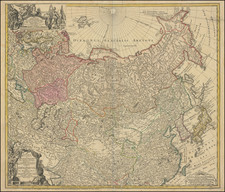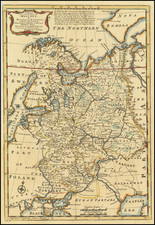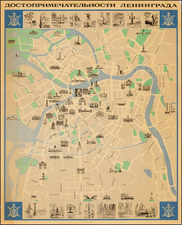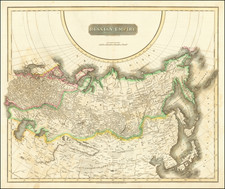Moscovia Urbs Metropolis Totius Russia Albae is a finely detailed plan of Moscow, created by the renowned mapmakers Georg Braun & Frans Hogenberg in 1617. This plan stands out due to its rarity; as part of the sixth volume of Braun & Hogenberg's Civitatus Orbis Theatrum, it is far less common than their initial plan of Moscow, published in 1575.
The origins of the map trace back to a Russian survey reportedly ordered by Boris Fyodorovich Godunov, Czar of Muscovy from 1598 onwards. While the original Russian plan has not survived, it is believed that Braun & Hogenberg based their work on a copy made for King Sigismund III of Poland in 1610.
The map displays the historic core of Moscow, encircling the Kremlin and the fortified Kitai Gorod. It provides a high bird's-eye view from the east, with the Moskva River meandering through the city. The plan provides a detailed view of the then-capital, including notable landmarks such as the Red Square and St Basil's Cathedral. The map further features two large market-hall complexes and provides a clear representation of the key buildings within the Kremlin walls, such as the Uspenski Cathedral and the Cathedral of the Archangel Michael.
This 1617 map serves as an important historical artifact, offering a valuable perspective of the spatial organization and architectural fabric of early 17th-century Moscow. It underscores the city's status as a vibrant metropolis and the heart of Russia's religious, secular, and royal life until the capital was moved to St. Petersburg in 1713.
Georg Braun (1541-1622) was born and died in Cologne. His primary vocation was as Catholic cleric; he spent thirty-seven years as canon and dean at the church St. Maria ad Gradus, in Cologne. Braun was the chief editor of the Civitates orbis terrarum, the greatest book of town views ever published. His job entailed hiring artists, acquiring source material for the maps and views, and writing the text. In this role, he was assisted by Abraham Ortelius. Braun lived into his 80s, and he was the only member of the original team to witness the publication of the sixth volume in 1617.
Frans Hogenberg (ca. 1540-ca. 1590) was a Flemish and German engraver and mapmaker who also painted. He was born in Mechelen, south of Antwerp, the son of wood engraver and etcher Nicolas Hogenberg. Together with his father, brother (Remigius), uncle, and cousins, Frans was one member of a prominent artistic family in the Netherlands.
During the 1550s, Frans worked in Antwerp with the famous mapmaker Abraham Ortelius. There, he engraved the maps for Ortelius’ groundbreaking first atlas, published in Antwerp in 1570, along with Johannes van Deotecum and Ambrosius and Ferdinand Arsenius. It is suspected he engraved the title page as well. Later, Ortelius supported Hogenberg with information for a different project, the Civitates orbis terrarium (edited by Georg Braun, engraved by Hogenberg, published in six volumes, Cologne, 1572-1617). Hogenberg engraved the majority of the work’s 546 prospects and views.
It is possible that Frans spent some time in England while fleeing from religious persecution, but he was living and working in Cologne by 1580. That is the city where he died around 1590. In addition to his maps, he is known for his historical allegories and portraits. His brother, Remigius, also went on to some fame as an engraver, and he died around the same time as his brother.









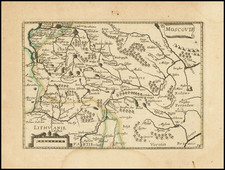
![[St. Petersburg, Russia]. Grond-Tekening van de Russische Hoosdstadt St. Petersburg, door Czaer Pieter de Eerstre In't Jaer 1703 aengelegt. . . . .](https://storage.googleapis.com/raremaps/img/small/40904.jpg)
